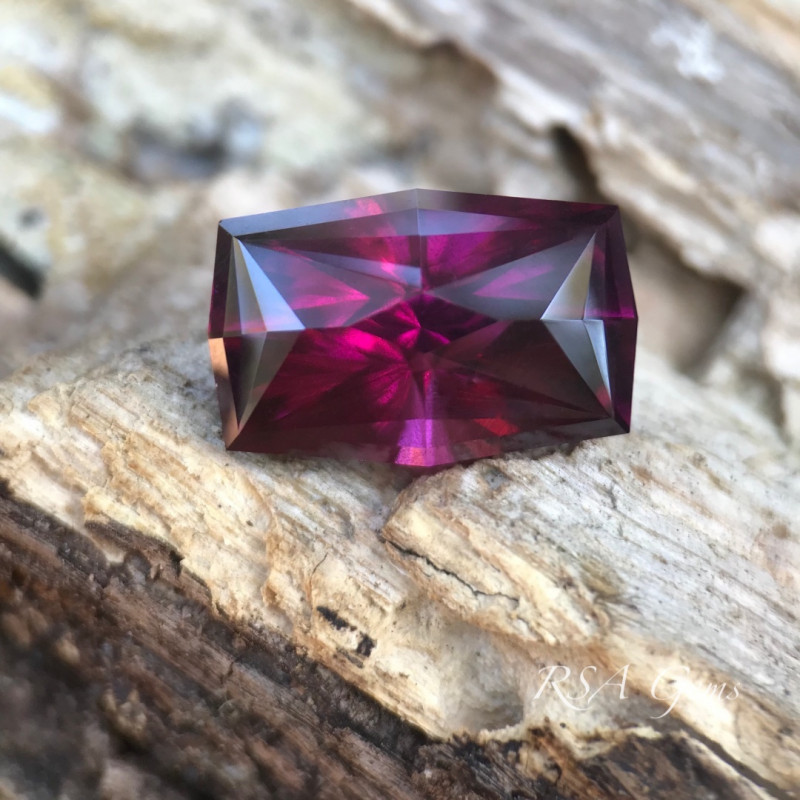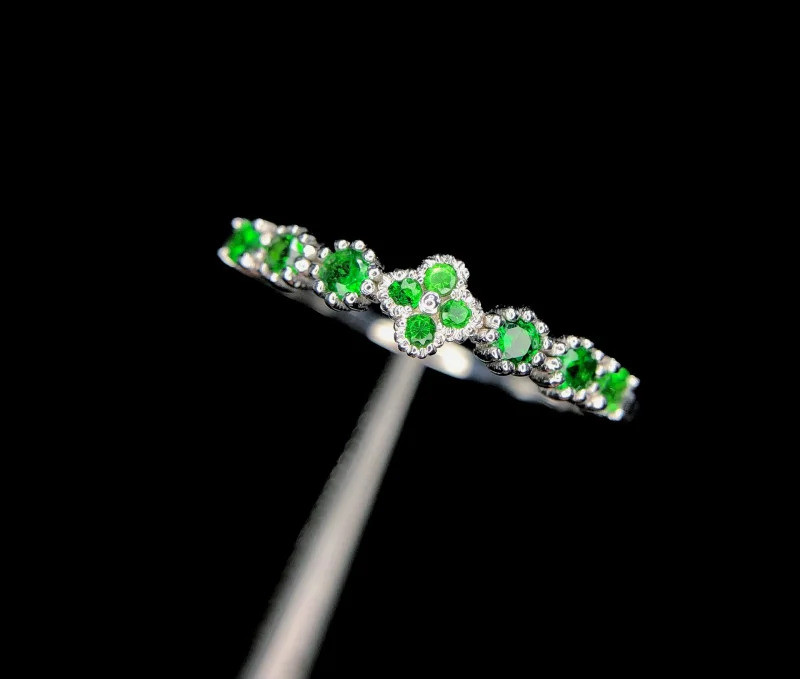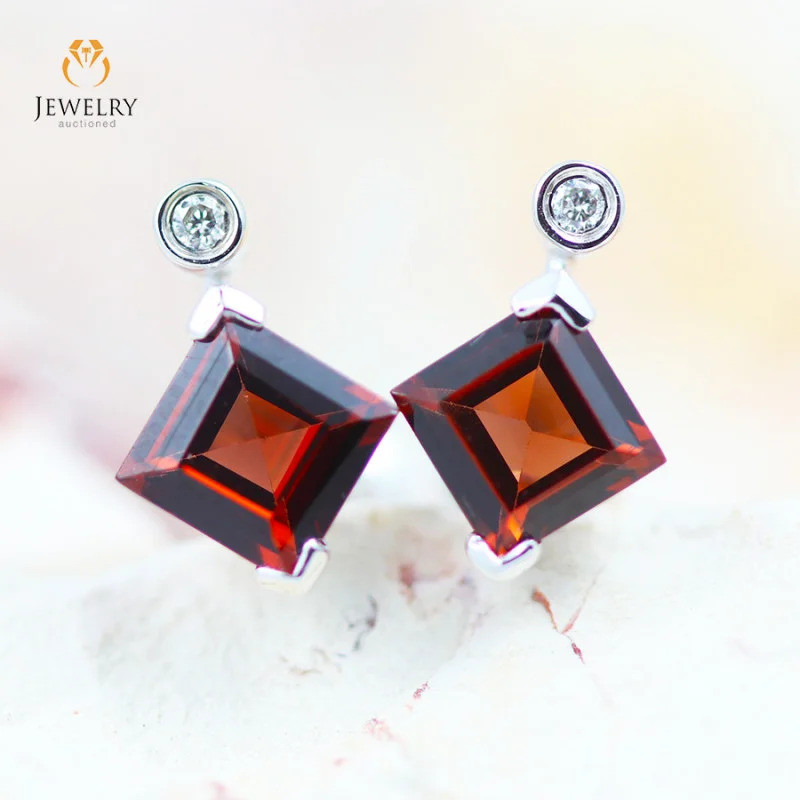
January's Birthstone: Kicking off the Year with Garnet
If your birthday kicks off the year, you’ll be happy to know that the January birthstone is the garnet. January is the month of new beginnings and positive outlooks on the future; garnet similarly reflects this brightness and scope of possibilities.
January’s name derives from Janus, the god of beginnings and endings in Roman mythology. Janus has two faces, each looking into the past or future.
In that vein, we’ll be looking at the traditional January birthstone garnet with its various meanings, history, and uses. We’ll also introduce some modern alternatives you can take into your future to celebrate being a January baby!

January Birthstone Meaning: Garnet Symbolism
Starting off with the symbolism, the January birthstone garnet generally represents friendship, warmth, and passion.
Another meaning of this semi-precious January stone is for protection, a use that goes back to ancient times.
Historical & Cultural Significance of January Birthstone Garnet
The January birthstone is most famously brilliant red but also comes in various shades, from pink or orange to green or purple.
The garnet also serves as the traditional 2nd wedding anniversary gemstone.
The name “garnet” derives from the medieval Latin term granatus, meaning “pomegranate” because small red garnet crystals resemble pomegranate seeds.
 Pictured above: Greek garnet and agate necklace and earrings dated 1st century BC | Image credit: Metropolitan Museum of Art, Public domain
Pictured above: Greek garnet and agate necklace and earrings dated 1st century BC | Image credit: Metropolitan Museum of Art, Public domain
Garnets in Ancient Times
Recorded uses for garnets date back to the Bronze Age (around 3300 BC to 1200 BC), when this January birthstone was used in abrasives, burials, and royal jewelry. Ancients also used garnets as talismans for protection while going to war and traveling, believing the gem would bring light to darkness.
Ancient Egyptian pharaohs wore red garnet necklaces in life and death, being buried with these July birthstones. Egyptians believed garnets symbolized life.
In ancient Rome, officials stamped documents with carved garnet signet rings. Romans traveling, going to battle, or avoiding illnesses like the plague would use garnet for protection.
One ancient Greek myth about garnet’s origins involves Persephone, the goddess of vegetation famously taken by and married to Hades, god of the underworld.
When Zeus told Hades to return Persephone, Hades gave Persephone a pomegranate. Once she ate the pomegranate seeds, she was attached to Hades eternally, spending half of every year (fall to winter) in the underworld.
As such, pomegranates and similar-looking garnets were associated with separated lovers, eternity, and the regenerative cycles of Earth.
Ancient Names for Garnets
Before “garnet,” other ancient terms for garnets (and similar red gemstones) included:
The Greek term anthrax (from Greek philosopher Theophrastus), meaning “glowing ember”
The Latin term carchedonius (from Roman writer Petronius), from the Greek name Carchedonia for Carthage, an ancient Phoenician city
The Sanskrit and Hindu raktamani, meaning “blood-red precious jewel”
The Latin terms carbunculus or carbuncle (from Roman scholar Pliny the Elder), meaning “burning coal”
Many early garnet names referenced their fiery qualities: red coloring, sparkle, and resistance to heat.
However, many red stones in ancient times were called “carbuncles,” so it’s hard to know if they were all truly garnets. Today, red garnet cabochons are still called carbuncles sometimes.
 Pictured above: 5th century (Early Medieval) Ostrogothic (Roman-era Germanic) garnet ring with engraved hatching | Image credit: Walters Art Museum, Public domain
Pictured above: 5th century (Early Medieval) Ostrogothic (Roman-era Germanic) garnet ring with engraved hatching | Image credit: Walters Art Museum, Public domain
Religious & Spiritual Significance
The January birthstone garnet has various religious or spiritual meanings and healing properties.
Christianity:
The Bible references garnet, as interpreted from the Hebrew word nophek, in clerical or royal adornments and as a beacon of guiding light on Noah’s Ark.
Some Biblical scholars interpreted these mentions of garnets, highlighting the gem’s blood-like color and ability to shine in darkness, to symbolize the sacrifice of Jesus Christ, God’s divine word, devotion to God, or Christian spirituality overall.
Clergymen in the Middle Ages (around 475 to 1450 AD) often wore garnet gemstones. Catholic bishop’s rings represented their religious authority and symbolic “marriage” to the church.
Some Christian scholars even claimed that ingesting powdered carbuncles would give one powers, honorable judgments, and spiritual awakening.
Pagans:
Frankish pagans like Childeric I believed red gems like garnets symbolized love, life, and fertility, using them for carvings of gods like Eros, Freia, and Isis.
Islam:
The Quran references seven heavens in the afterlife, with the sixth heaven being made of garnets and rubies. Gemstones in the Quran often symbolized the blessings of Allah.
Hinduism:
Hindu energy healers use garnet as a root or crown chakra stone. Vedic astrologists also associate red garnet with “Rahu” or Mars, the planet of energy and war, believing garnets offset negative effects of Mars.
Overall, garnets held many meanings, for both healing and harm.
Some Native American and Asian tribes would use red garnets as bullets to ensure fatal damage, while Medieval physicians treated various ailments with garnets, including fevers, wounds, jaundice, and even the bubonic plague.
Geology and Composition of the January Stone Garnet
Garnets are actually a large, complex group of minerals with a tree of categories. The two overarching series of gem-quality garnets are pyralspite and ugrandite:
Pyralspite: Aluminum-rich silicates; Contains the species pyrope, almandine, and spessartite
Ugrandite: Calcium-rich silicates; Contains the species uvarovite, grossular, and andradite
Many garnet varieties are mixtures of those species, often within the same series but sometimes criss-crossing between the series.
Let’s go over the pyralspite species of these January birthstones first.
Pyrope
 Pictured above: Faceted Umbalite garnet from Mozambique
Pictured above: Faceted Umbalite garnet from Mozambique
The most well-known red garnet variety, pyrope garnets are magnesium aluminum silicates popular for their blood-red or pomegranate coloring. Pyropes are the only consistently red garnets, though their exact shades vary with undertones of purple, orange, black, and brown.
Varieties of pyrope birthstones include:
Chrome Pyrope
Pastel Pyrope
Mozambique Garnets
Star Garnet
Umbalite
Grape Garnet
Almandine
 Pictured above: Faceted rhodolite garnet
Pictured above: Faceted rhodolite garnet
Almandine is another extremely popular garnet variety. This iron aluminum silicate is slightly harder than pyrope. Its colors range from deep reds and purplish-reds to browner hues.
Almandine varieties include:
Mozambique Garnets
Rhodolite
Malaya (Malaia) Garnet
Star Garnet
Umbalite
Grape Garnet
Proteus Garnet
Spessartite
 Pictured above: Faceted mandarin garnet
Pictured above: Faceted mandarin garnet
Spessartite garnets are the more unique pyralspite species, known for their yellow to orange coloring and very high brilliance. The varieties of this manganese aluminum silicate include:
Malaya (Malaia) Garnet
Kashmirine
Cat’s Eye Spessartite Garnet
Umbalite
Now we’ll get into the ugrandite species!
Uvarovite
 Pictured above: Uvarovite garnet druzy
Pictured above: Uvarovite garnet druzy
Uvarovite is a calcium chromium silicate and the rarest gem-quality garnet species. It’s also the only garnet to be consistently green, ranging from medium to dark shades.
Grossular
 Pictured above: Silver ring with green tsavorite garnets and cubic zirconia
Pictured above: Silver ring with green tsavorite garnets and cubic zirconia
Grossular garnets are calcium aluminum silicates, with iron sometimes replacing some of the calcium and aluminum. They’re known for having the widest range of colors and the only gem-quality colorless varieties.
Grossular garnet varieties are:
Imperial Garnet
Mint (or Merelani Mint) Garnet
Leuco Garnet
Umbalite
Some consider hydrogrossular garnet a grossular variety, but it’s debated among gemologists.
Andradite
 Pictured above: Gold ring with green demantoid garnet and pink diamonds
Pictured above: Gold ring with green demantoid garnet and pink diamonds
Andradites are calcium iron silicates with exceptionally high dispersion (colorful sparkle) and brilliance (flashes of white light). Though not as popular and rarer than other species, andradites have some sought-after varieties, like:
All of those varieties contribute to the beautiful rainbow of garnet colors and optical effects present in these January birthstones!
 Pictured above: Purple star garnet
Pictured above: Purple star garnet
Captivating Colors and Variations
What color is the January birthstone? Garnet is most popularly red, but it actually comes in a wide array of colors, and some varieties even have special optical effects.
Garnets By Color
The January birthstone color can be virtually any hue, though blue is extremely rare and only present in some color-changing varieties.
The most popular varieties for each color of this January birthstone are:
Red: Pyrope
Orange: Mandarin Garnet
Yellow: Mali garnet
Green: Demantoid or tsavorite
Purple: Umbalite or grape garnet
Pink: Rhodolite
Colorless: Only leuco garnets (grossular)
Black: Melanite
Besides varying colors, garnet January birthstones are also available with unique optical effects.
Optically Phenomenal Garnets
Garnet birthstones with optical phenomena include:
Star Garnet: Displays a 4, 6, or even 12-rayed “star” of reflected light via asterism; Usually black, brown, or dark purplish-red but can be various shades of red to purple including reddish-black and blackish-purple
Cat’s Eye Garnet: Reflect a ray of light resembling a cat’s eye via chatoyancy due to parallel inclusions of needle-like fibers or hollow tubes; Always spessartite
Color-Change Garnet: Change color in different lighting, usually UV (sunlight) and incandescent light; Usually red to purple or red to green; Most valuable are blue to red or purple
Besides phenomenal optics, garnets also come with phenomenal healing properties.
 Pictured above: Faceted color-change garnets
Pictured above: Faceted color-change garnets
Garnet’s Metaphysical Properties
The January birthstone’s use as a healing stone has persisted since ancient times into modern crystal healing practices.
Many of garnet’s metaphysical uses are related to its associations with blood and the heart, symbols of life, strength, and love.
Physically, garnet birthstones are said to improve blood circulation, strengthen the heart, and cleanse the body of toxins, like real blood does in our bodies.
In energy healing, garnets are used for balancing all the chakras, allowing energy to flow freely throughout one’s entire physical, spiritual, and emotional being.
Emotionally, the January birthstone garnet is said to boost:
Confidence
Passion
Determination
Fertility
Resilience
Those in relationships can benefit from garnet’s purported abilities to help you become more comfortable being vulnerable, release negative feelings like resentment or anger, and increase feelings of passion for each other.
Zodiac Stones for January
Two astrological signs fall under the January birthstone time period: Capricorn from December 22 to January 19 and Aquarius from January 20 to February 18.
Garnet’s symbolism in friendship, warmth, and passion matches its use as an Aquarius birthstone. Air sign Aquarians are said to be passionate humanitarians who value friendship and community building.
Garnets can also symbolize trust and devotion, romantic or otherwise, emblemized with the nickname “Stone of Commitment.” This better ties to garnet as a Capricorn birthstone. Capricorns are devoted and reliable leaders, both at work and at home.
Outside of garnet, there are a few other January birthstones to know about.
 Pictured above: Beaded bracelet with rose quartz and red garnets
Pictured above: Beaded bracelet with rose quartz and red garnets
Alternative January Birthstones
The most common birthstone color for January is red or some variation of it, like pink or purple.
The main January birthstone alternative to garnet is rose quartz, a lighter complement to the fire of garnet. This pink quartz variety is often milky and translucent. The January birthstone alternate also symbolizes universal love and acceptance.
The mystical January birthstone, based on Tibetan astrology, is emerald. Though strikingly different with green hues instead of red, emeralds as January birthstones reflect the symbolism of personal growth and rebirth associated with the new year.
Compared to garnet, rose quartz is less durable but more widely available. The two stones make a great combination in January birthstone jewelry.
Emerald is usually more durable than garnet, but often more expensive with lower clarity.
Personalized January Birthstone Gifts
Though some view the idea of birthstones as purely a marketing ploy, birthstones carry a long history of significance. In fact, the idea of birthstones by month goes back to Biblical texts.
Birthstones are often the first crystal people become familiar with. They’re thought to bring the wearer protection and luck, but on a less spiritual level, birthstones are a celebration of life.
Whether you buy your own birthstones or gift them to a loved one, there are various ways to use January birthstones:
As a single gemstone necklace or earrings
On jewelry with the birthstone(s) of a loved one(s)
On cufflinks
As part of a stacked ring set
Adorning a personalized name plaque
As carved (or raw crystal) room decor
The list goes on, so get creative! After all, it’s your birthstone, so rock it however you’d like.
 Pictured above: White gold earrings with red garnets and white diamonds
Pictured above: White gold earrings with red garnets and white diamonds
Celebrate the New You with January Birthstones!
If you’re a January baby, you know you shine as the year’s kickstarter and a reflection of the future’s brightness — your birthstone should reflect that too! Whether you go with the timelessly charming garnet or an alternative like rose quartz, what’s important is that you have a birthstone that celebrates you.
Find traditional and alternative January birthstones from our hundreds of gemstones available!
Search the Gemstone Encyclopedia
Related Auctions
Related Articles
There are dozens of quartz and chalcedony gems with various colors and patterns. Learn all about quartz properties and every type of quartz, from amethyst and agate to plasma and phantom quartz!
15th Oct 2020
Let us explain how to buy gems on the internet. We have the largest range of gemstones on the internet and it can be a little overwhelming at first. Let us help you with some useful tips.
3rd Oct 2018
Have you ever wondered how they treat Ruby gemstones? There are so many different types of treatments on the market and we will help to explain them
9th May 2018
Latest Articles
Friedelite is an uncommon pink, red, or brown manganese silicate mineral best known from New Jersey and South Africa. Learn the prices, properties, uses, and history of friedelite gemstones.
23rd Dec 2024
Shortite is a rare mineral and rarer gemstone, usually found as colorless or yellow wedge-shaped crystals. Learn the value, history, and properties of shortite in this guide!
9th Dec 2024
Senarmontite is an uncommon antimony mineral mostly used industrially but occasionally collected as rare gems or pearly crystals. Find out all of the traits, uses, prices, and history of senarmontite.
27th Nov 2024
Article Categories
How To's is where you will find helpful articles from gem Rock Auctions on how to cut gemstones, select gemstones and buy gemstones.
9 Articles




